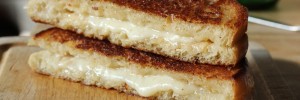by Ruth Reichl January 2, 2012
“We spend a lot of time sitting around this office, talking about what we cooked, what we’re going to cook, and what we wished we had cooked. Lately it’s occurred to us that you might want to be part of this conversation.
Starting today, I’ll be writing a weekly column called How to Make a Better… These aren’t recipes, really, just simple ideas that will help you turn good food into great food.
These are little tricks I’ve come up with over many years, and I mostly keep them to myself. But our goal at Gilt Taste is to help everyone become a better cook, and I’m excited to share them with you. I wish you a year of wonderful eating.”
How to Make a Better Grilled Cheese Sandwich
A great grilled cheese sandwich is a seriously seductive creature. Warm, tangy and gooey, it should be absolutely irresistible. But here’s the problem: Even ordinary grilled cheese sandwiches, the kind made with white bread and Velveeta, are pretty appealing. Which means that too many people are willing to settle for good enough.
That’s a shame: Making it better is remarkably easy. Here are a few tips, beyond the obvious ones of using good bread (something with character like sourdough) and good cheese (any good Cheddar will do, although I prefer Montgomery).
- Do not use margarine – ever. Butter the inside and the outside of the bread. Or try spreading a thin film of mayonnaise onto the outside of the bread instead of butter; it will not only add a persuasive tang, but is also much more scorch-proof on the griddle.
- Grate the cheese rather than slicing it for quicker, more even melting.
- Mix the grated cheese with a scattering of finely chopped members of the allium family – whatever you happen to have on hand. I like to mix in about a tablespoon of onions, scallions, shallots and a little bit of garlic per sandwich.
- Add a gentle swipe of mustard (or horseradish) to the inside of the bread. It adds a nice layer of flavor, an extra tang.
- Pat some of the grated cheese onto the outside of the bread, where it will create a wonderfully crisp and shaggy crust, giving your sandwich an entirely new dimension.
- Don’t take your eyes off the griddle; the easiest way to make your grilled cheese better is to make sure these babies don’t burn!
*Ruth Reichl is the Editorial Advisor to Gilt Taste. She was the Editor in Chief of Gourmet magazine for ten years until its closing in 2009. Before that she was the restaurant critic of The New York Times, (1993-1999), and both the restaurant critic and food editor of the Los Angeles Times (1984-1993). She is the author of Tender at the Bone, Comfort Me with Apples, and Garlic and Sapphires among other books.

